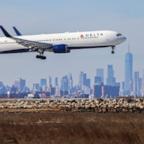FAA removes emergency oxygen from airline lavatories
— -- Airlines earlier this year quietly removed the emergency oxygen from lavatories because of concerns that it could be used to start a fire.
Safety officials now are working with aircraft manufacturers to develop a secure oxygen system. Trouble is, it'll take two to four years to complete the job, the Federal Aviation Administration says.
That's not fast enough for safety advocates and flight attendants. They're concerned that passengers, flight attendants and pilots using a lavatory could be seriously harmed or killed if there is an aircraft decompression and emergency oxygen is needed immediately at a high altitude.
The FAA ordered airlines to remove the chemical oxygen generators in lavatories because they "were easily accessible and could have been manipulated to create a flight hazard."
The decision, made in conjunction with the Transportation Security Administration and the FBI, "was purely a precautionary measure," and "there is no credible or specific threat at this time," the FAA says in written responses to USA TODAY questions.
The agency "expects that it will take between two and four years to design, develop and install a secure lavatory oxygen system in all U.S. operated passenger aircraft," the FAA says. "Safety officials are working as quickly as possible with aircraft manufacturers to find a permanent solution."
Commercial jets normally cruise at an altitude of about 35,000 feet. In a 1996 advisory issued to airlines, the FAA said that "exposure to cabin altitudes in excess of 25,000 feet for more than two minutes without supplemental oxygen could in some cases cause permanent physiological (brain) damage." Without supplemental oxygen at 25,000 feet, most people will be unconscious in three to 10 minutes, the advisory said.
Removal of oxygen from lavatories, each of which was equipped with two oxygen masks, did not affect oxygen stored above passenger seats.
The FAA says flight attendants "have their own mobile masks" and are trained to assist passengers in lavatories after an aircraft decompression. Flight attendants, though, say it's not that seamless, and it could take some time before they can help passengers. They're trained to grab the nearest available fixed oxygen mask and remain there until told by a pilot that it is safe to move around the cabin and assist passengers, airlines and the Association of Flight Attendants union say. The union, which represents about 60,000 flight attendants at 24 airlines, says its members are trained to use portable oxygen masks but only to retrieve them after pilots say it is safe.
The Air Line Pilots Association, which represents more than 53,000 pilots at 37 U.S. and Canadian airlines, would not comment.




